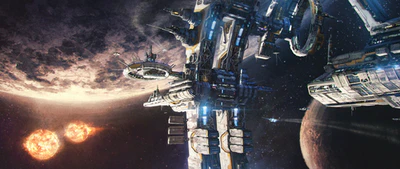
Baker is a binary system consisting of two K-type main sequence stars surrounded by a relatively desolate collection of planets that range from completely uninhabitable to barely habitable. The binary stars have drawn the attention of astrophysicists eager to study such a phenomenon. A Covalex shipping hub and a largely automated mining outpost are the primary bastions of civilization in the region. As usual, that’s only half of the story — the Baker system is also home to the “Able Baker Challenge,” arguably underground racing’s most dangerous event.
The first successful transit to Baker occurred in 2522 when the jump point to Baker was discovered by accident in the Kiel System. Baker remained relatively forgotten due to the fact that binary stars traditionally offer little of value to Humans. Even when a planet within a binary star’s green zone can be terraformed, the gravitic stress associated with passing close to (or between) two stars renders attempts at civilization a moot point. However, Baker was subsequently explored by a purely scientific expedition.
From a settlement-or-resources standpoint, Baker’s first three worlds were written off immediately after the system was charted. None can be terraformed in a fashion that will sustain life permanently, and none have resources that make traveling close to the system’s stars worthwhile for major corporations. Baker I is a small planet with a dense iron core that is in a dangerously close orbit around Baker’s two suns. This proximity leads to an unstable orbital trajectory, and scientists posit that its orbit will steadily decay until it is subsumed by the larger star within the next one hundred and fifty million years.
Baker II is a typical smog planet, a sickly yellow-green worldlet with a dense and highly poisonous atmosphere. While not significantly crushed by the stars’ gravity during its rotation, Baker II’s atmosphere is so unsupportive of Human life that terraforming has never been a serious option here. In fact, the toxic mix is also incredibly corrosive to standard spacecraft hulls; the planet made headlines recently when a Freelancer piloted by suspected gunrunners attempted to hide out at Baker II only to find their ship literally dissolving out from under their feet. Baker III is an ice giant, a churning mass of white with deep blue veins. The planet’s circumference has increased noticeably since its discovery, something astrophysicists are keeping a watchful eye on.
Xenia is a Covalex shipping hub constructed to support the burgeoning trade lanes between Baker and the Xi’An Empire. Xenia has expanded by leaps and bounds with the realization that operating through the station allows merchants to avoid the increasingly high tariffs associated with moving goods through more populated systems.
The station itself has grown into a series of pre-fab habitation facilities joining together cargo bays to form a ring. These bays range from pressurized hangars for smaller ships to massive vacuum ‘wet docks’ capable of servicing the largest freighter designs. Larger ships flying under Covalex registry and carrying bulk goods typically disperse their cargo at Xenia, where private enterprise crews can pick up contracts for delivery to the surrounding systems.
Xenia is a great place for newly formed hauler crews to learn the tricks of the trade. There’s not a great deal of profit in helping Covalex avoid import taxes, but it is ideal for inexperienced crews looking to find their space legs. The station’s active job board is also a good place to pick up longer duration missions with higher payouts.
The final planet in the Baker system has no atmosphere or magnetic field, but it is home to very dense mineral deposits. Shubin Interstellar has been granted claim rights to the planet and a mining outpost named GIO is now the planet’s most noteable feature. Spacecraft can come and go from GIO, although the Shubin-constructed facilities on the planet are spartan at best.
The Race
While Baker’s three inner planets may be useless in any formal sense, they have taken on new life as one of the galaxy’s most dangerous unofficial racetracks where the Able Baker Challenge pits pilots against each other and the environmental dangers.
Brave pilots who flew in past races had to face severe and often deadly challenges. One year saw the participants having to navigate the space that surrounds Baker III, which is filled with dangerous ice crystals that can impair instrumentation and severely hamper visibility. Another race featured a stage called ‘breathing the vapors.’ that involved ring targets placed very close to Baker II’s toxic atmosphere. Pilots had to traverse the course carefully to avoid hull damage. There have often been races that included final legs that are weapons-free. Unlike more “civilized” events, this means racers are not immediately disqualified for the destruction of an opponent’s ship (although kills are still frowned upon).
This makes for one of the most dangerous competitions in the galaxy. Navigating the course is considered a badge of honor among underground racers, although official racing teams avoid the Able Baker Challenge for the most part. As it is an unofficial race organized by unknown concerns, the challenge has no rules concerning weapons or other safety procedures, and especially competitive racers have been known to gun down opponents even in early race phases in order to gain an edge.
Visitors should also be aware that the underground nature of the challenge has led to a significant number of casualties among amateurs.
Travel Warning
As Baker has no recognized worlds, it is patrolled irregularly by the UEEN. You may find yourself in danger when traveling in the system.
